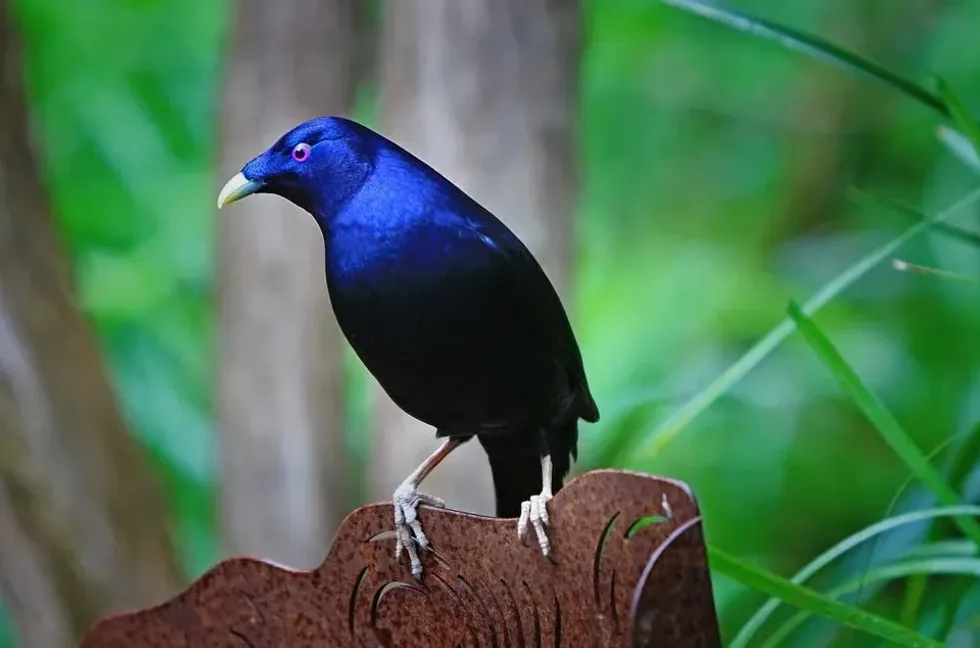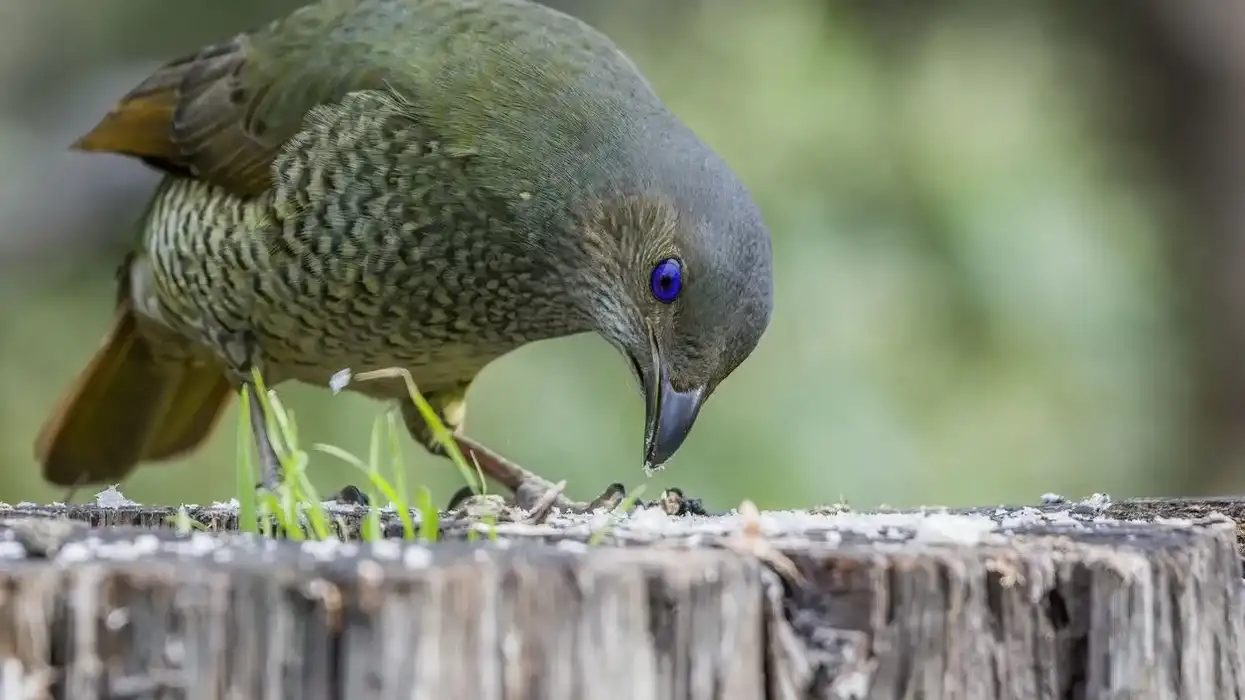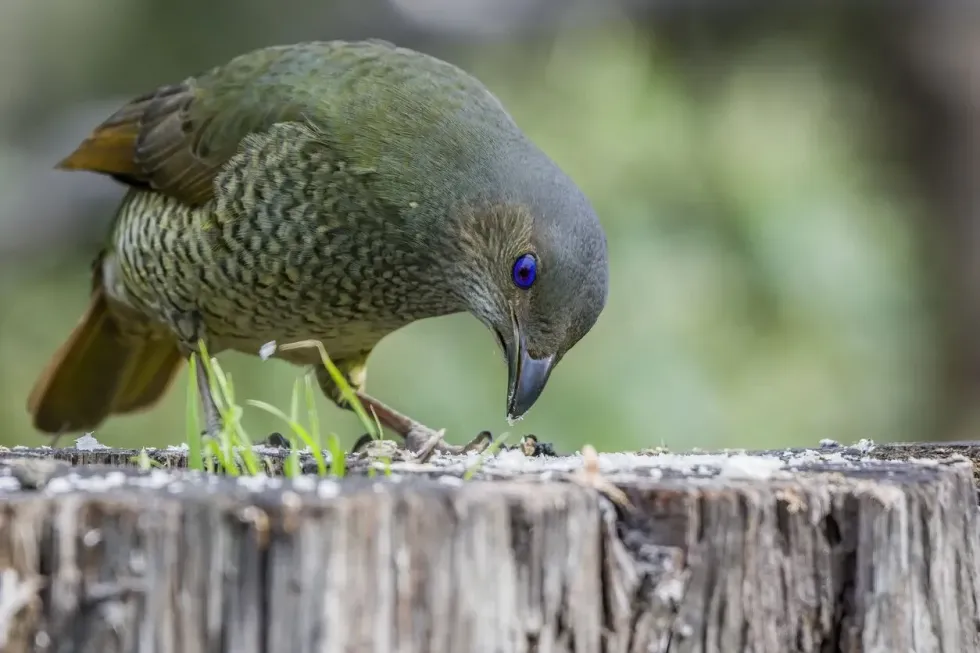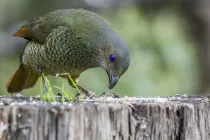Fun Bowerbird Facts For Kids

Bowerbirds are amazing birds that are also creative engineers! The satin bowerbird species from Australia (Ptilonorhynchus violaceus) is famous for its beautiful sense of decoration and its peculiar tradition of males decorating nests with bright colored stones, flowers, or insect skeletons to attract females.
The male bower is famous all over for creating complex yet beautiful structures as part of their mating ritual and the structures created by the male species bower can be divided into three main types (avenue, display courts and maypole structures).
Male bowerbirds keep rearranging their nest structure repeatedly until they attract a female for mating. According to the IUCN red list they classified as Least Concern, so are not at risk of extinction.
Let's learn more about the amazing bowers species! You can also read our guides to the frigate bird and crowned eagle to learn more about different bird species.
Bowerbird Interesting Facts
What type of animal is a bowerbird?
Bowerbirds are part of the bird family called Ptilonorhynchidae.
What class of animal does a bowerbird belong to?
Bowerbirds belong to the class Aves and family Ptilonorhynchidae.
How many bowerbirds are there in the world?
There are a total of 20 species of bowerbird present worldwide. These birds are known for their art and architectural skills but quite a few species of bower are either exceedingly rare or are threatened. The country where they are easiest to find is Australia.
Where does a bowerbird live?
Bowerbirds can survive in tropical forests, rainforests, savanna woodlands, arid zones of Australia, grasslands, and temperate regions. Out of the total 20 species, 10 are known to live in just New Guinea and eight in Australia. The remaining two are common to both regions.
What is a bowerbird's habitat?
A bowerbird's habitat lies across specific regions on the island of New Guinea in the South Pacific as well as parts of Australia that consist exclusively of tropical forests, mangroves, eucalyptus stands, and savanna woodlands.
Who do bowerbirds live with?
Depending on the species, the adult males in this species live in solitary, while the green catbird spends the majority of their time with their large flock. This flock takes sweeps into the orchids during the winters. They also feed in flocks where the adults dominate the younger ones.
How long does a bowerbird live?
The approximate life span of a satin bowerbird (Ptilonorhynchus violaceus) is between 20 to 30 years. The satin bowerbird and green catbird have the same life expectancies and many male bowerbirds have managed to make it to 30 too.
How do they reproduce?
Bowerbirds can reproduce sexually or asexually. Their asexual mode of reproduction happens through fission, budding, fragmentation, or parthenogenesis. Sexual reproduction involves fertilization, either internal or external (this depends on and widely varies among the different types of bowerbirds).
Species like the Ailuroedus (a genus in the bowerbird family) catbirds are mostly monogamous, with the males raising chicks with their partners. That said, most other bowerbirds are known to be polygynous, with females building the nests and raising young alone.
Females typically lay two eggs in a shallow nest of sticks and twigs, and leaves of acacia or eucalyptus are placed on top of the eggs. These leaves serve as excellent camouflage from the prying eyes of predators, as they turn brown when the eggs are laid.
The mating ritual of bowers is famous as the males decorate and create displays to attract a mate. This involves making elaborate structures for their bowerbird nests and decorating them to the best of their abilities.
The male decorates the nest with bright-colored objects other than twigs and leaves in order to attract the female. Once females are attracted and the process of fertilization is complete, the eggs are laid at once and are further camouflaged with leaves to protect them.
What is their conservation status?
Since bowerbirds are quite a common species in Australia and are easily spotted in Australia, they are marked as Least Concern on the IUCN red list of threatened species.
Bowerbird Fun Facts
What do bowerbirds look like?
There are various varieties of bowerbird, each variety differing in its looks. The head, back, and plumage of the male regent bowerbird are colored in a rich golden-yellow, with the body being black with a purple sheen.
Its forehead is tinted crimson and it has bright yellow eyes. The male bowerbirds and females of this species look the same until the male turns four years old. The female is colored in shades of dull brown, with yellow-brown on the upper parts of her body and brown mottling underneath.
Male satin bowers birds are approximately 12 in (30 cm) long, with a glossy purple sheen. The female satin bower is a little smaller in size and her body is wrapped in a dusky brown or grey-green shade. Both the female and male bowers of this species tend to have bright lilac-sea eyes, making them all the more attractive.
The overall body of both male spotted bowerbirds and female spotted bowerbirds is dipped in a brown shade with a beautiful bright bar at the back of their necks. Their spots can be seen all over their feathers, making them look quite more attractive.

How cute are they?
Bowerbirds are blessed with beautifully colored feathers all over and beautiful beaks. This makes them quite adorable and they are a real treat to witness in real life. There is no doubt that these birds are super cute, particularly the satin bowerbird!
How do they communicate?
The prime form of communication used by these birds is seen during their mating season, where they use a remarkable method to catch the eyes of their potential mates. Males also tend to show off their dancing skills and their singing power to attract females.
The elaborate satin bowerbird courtship behavior is astonishing to behold and, whilst some birds have excellent plumage, other birds use even more complicated mating dances to attract a mate.
How big is a bowerbird?
While golden bowerbirds are roughly around 8 in (22 cm) tall, the great bowerbird gets as big as 16 in (40 cm) tall. The regent bowerbird is 10-12 in (26-30 cm) long.
How fast can a bowerbird fly?
The satin bowerbird species is known for its rapid flight from tree to tree. These birds are known for the heights they reach, as well as the fast pace of their flights. When flying in flocks, they tend to fly clearly above treetops and can be seen clearly in the sky.
How much does a bowerbird weigh?
The weight of these birds varies from species to species. While the golden bowerbird might weigh around 2.4 oz (70 g), the great bowerbird can with anything up to 8.1 oz (230 g). These birds are roughly ten times smaller than a labrador!
What are their male and female names of the species?
The females and males of the species are not given different names.
What would you call a baby bowerbird?
There are some specific names for babies of different birds or animals, but in this case, there is no specific name for the young of the bowerbirds. You can simply call them baby bowerbirds.
What do they eat?
These birds usually feed on fruits from trees throughout the year, however, during the breeding season (in summer) they tend to increase their diet by feeding on insects while supplementing themselves with leaves during the winters.
How high can they fly?
This species can cover great distances vertically in order to avoid any kind of human intervention or to prevent any threat to their eggs or nests. They can fly up to 16,000 ft (4,877 m) vertically above sea level!
Would they make a good pet?
Although bowerbirds are very attractive (their plumage especially), they would not make a good pet as they belong in the wild.
Did you know...
Bowerbirds have a maximum life expectancy of approximately 26 to 30 years. There are many different types of bowerbird, including the female and male flame bowerbird, MacGregor's bowerbird, the golden bowerbird, the New Guinea bowerbird, the streaked bowerbird, the satin bowerbird, the Australian bowerbird, the Vogelkop bowerbird, the blue bowerbird, and the masked bowerbird.
One of the best satin bowerbird facts is that the sticks they collect play a major role in the decorations they create. These birds collect their sticks carefully and arrange the sticks in a manner that gives the nest an overall good structure so that it is safe as well as beautiful.
A satin bowerbird (Ptilonorhynchus violaceus) is known for its beautiful architectural skills. Their name itself signifies the existence of a beautiful retreat ('bower').
They are also known for their unique courtship behavior where the male decorates his retreat in order to attract females. Another peculiar thing about bowerbirds is their unique elaborate courtship.
The courtship behavior of bowerbirds is about more than the decoration skills of the bower. It continues further where the bird uses his saliva, mixed with some sticks and plant material, to paint the walls of his creation to make it even more attractive.
Competition among male bowers for the best decorative items is high. Often, male bowers are witnessed fighting with one another to steal the perfect trinket for their respective nests to look better than the others.
Even after the female chooses the bower of her choice, the mating session doesn't end there. After the female has made her decision, the male displays his bowerbird dance while holding a favorite trinket (plant material) in his beak. This dance further impresses the female.
What is odd about the bowerbird mating ritual?
The satin bowerbird courtship and mating ritual might seem a little odd and peculiar. Bower males decorate their nests in the best possible way to attract females for mating. Male great bowerbirds are among the most complex natural architects of all. They are known to collect beautiful bright objects, making their nests even more attractive to the females.
Why do bowerbirds collect blue?
Satin bower birds, as we know, decorate their nests in order to make their nests look super attractive. They usually prefer brightly colored objects for their works of art.
Scientists have said that, not only do bowerbirds work hard to collect the best bright-colored objects, but they also tend to steal them from each other to make their own bowerbird nest even more attractive!
Two basic theories might give us the actual reason as to why these birds pick the color blue most commonly.
The first theory is that since satin bowerbirds are themselves blue in color, the male bowerbirds may pick the color blue to best show themselves off to the female. The second possible theory is that there might be different color schemes for different birds.
For instance, blue might be the 'allotted' color for the satin bowerbirds and this would describe why male satin bowerbirds are naturally drawn to this beautiful color!
Here at Kidadl, we have carefully created lots of interesting family-friendly animal facts for everyone to discover! Learn more about some other birds including the great green macaw or the harpy eagle.
You can even occupy yourself at home by drawing one on our bowerbird coloring pages.
We Want Your Photos!
More for You
See All
Bachelor of Commerce specializing in Accounting and Finance, Master of Business Administration

Divya RaghavBachelor of Commerce specializing in Accounting and Finance, Master of Business Administration
With a diverse range of experience in finance, administration, and operations, Divya is a diligent worker known for her attention to detail. Born and raised in Bangalore, she completed her Bachelor's in Commerce from Christ University and is now pursuing an MBA at Narsee Monjee Institute of Management Studies, Bangalore. Along with her professional pursuits, Divya has a passion for baking, dancing, and writing content. She is also an avid animal lover who dedicates her time to volunteering for animal welfare causes.
Bachelor of Science specializing in in Computer Science

Diya PatelBachelor of Science specializing in in Computer Science
A member of Kidadl's fact-checking team, Diya is currently pursuing a degree in Computer Science from Ahmedabad University with an interest in exploring other fields. As part of her degree, she has taken classes in communications and writing to expand her knowledge and skills.
Disclaimer
1) Kidadl is independent and to make our service free to you the reader we are supported by advertising. We hope you love our recommendations for products and services! What we suggest is selected independently by the Kidadl team. If you purchase using the Buy Now button we may earn a small commission. This does not influence our choices. Prices are correct and items are available at the time the article was published but we cannot guarantee that on the time of reading. Please note that Kidadl is a participant in the Amazon Services LLC Associates Program, an affiliate advertising program designed to provide a means for sites to earn advertising fees by advertising and linking to Amazon. We also link to other websites, but are not responsible for their content.
2) At Kidadl, we strive to recommend the very best activities and events. We will always aim to give you accurate information at the date of publication - however, information does change, so it’s important you do your own research, double-check and make the decision that is right for your family. We recognise that not all activities and ideas are appropriate for all children and families or in all circumstances. Our recommended activities are based on age but these are a guide. We recommend that these ideas are used as inspiration, that ideas are undertaken with appropriate adult supervision, and that each adult uses their own discretion and knowledge of their children to consider the safety and suitability. Kidadl cannot accept liability for the execution of these ideas, and parental supervision is advised at all times, as safety is paramount. Anyone using the information provided by Kidadl does so at their own risk and we can not accept liability if things go wrong.
3) Because we are an educational resource, we have quotes and facts about a range of historical and modern figures. We do not endorse the actions of or rhetoric of all the people included in these collections, but we think they are important for growing minds to learn about under the guidance of parents or guardians.







